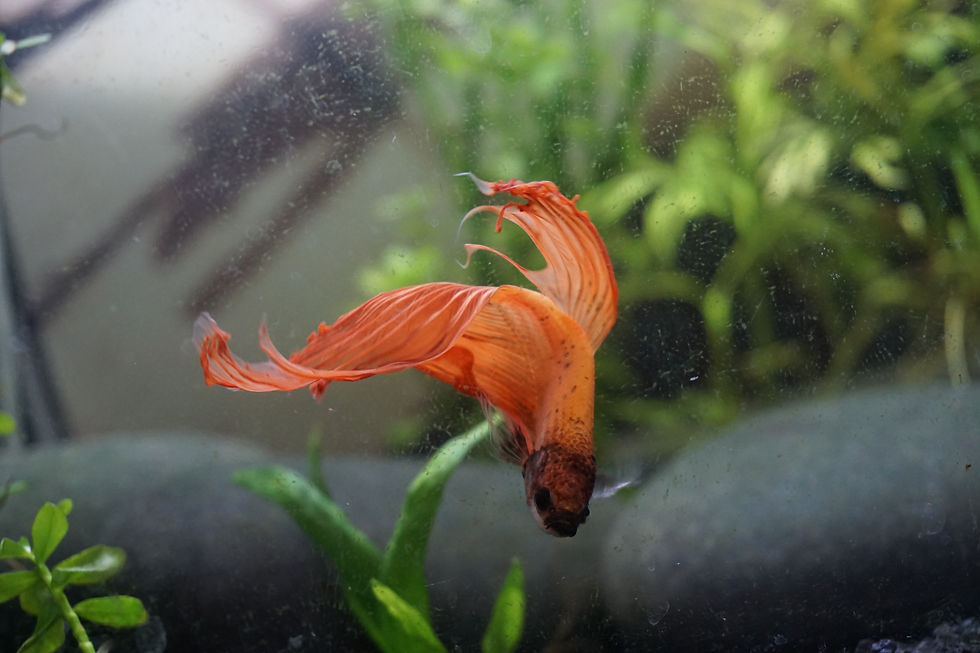Establishing the Nitrogen Cycle
- Betta Buddies

- May 4, 2019
- 3 min read
NOTE: If you have already purchased fish, and placed them in an uncycled tank, read our other article, “Establishing a Fish-In Nitrogen Cycle,” in addition to this article. Establishing a nitrogen cycle is one of the most important aspects of any tank. Every tank should have an established nitrogen cycle before adding ANY fish or other aquatic creatures. A tank without a nitrogen cycle can greatly harm fish, from weakening their immune systems to giving them ammonia or nitrite poisoning. But what is a nitrogen cycle exactly? The nitrogen cycle is the natural breakdown of ammonia into nitrate by bacteria that lives in your tank's filter and substrate. The cycle has three distinct stages, and each stage takes time to establish. There are ways to speed this process up, which we will cover later in the article. Stage one: Ammonia is introduced Stage one begins when ammonia is introduced into the aquarium. Ammonia is introduced in different ways, such as the waste excreted by your fish, and rotting uneaten fish food. Ammonia is a HIGHLY toxic chemical to fish, and levels above 1ppm (parts per million) should be removed immediately by doing an emergency water change. The ideal ammonia measurement in aquariums is 0ppm, anything above that will harm your fish. Stage two: Ammonia turns into nitrites After ammonia is introduced, one of the two types of helpful bacteria necessary for the nitrogen cycle will begin to appear. These bacteria, called Nitrosomonas, eat up the ammonia, and convert it into nitrite. The ammonia disappears, but a new issue arises, which is the nitrite! Nitrite is also toxic to fish, and impedes their blood's ability to carry oxygen, which can cause fish to suffocate, even with ample oxygen present in the water. Similar to ammonia, nitrite above 1ppm should be removed immediately, and any reading above 0ppm is considered dangerous. Stage three: Nitrites turn into nitrates Stage three is when the nitrite present in the aquarium is turned into nitrate. This process is done by helpful bacteria known as Nitrobacter bacteria. Nitrate, unlike ammonia and nitrite, is not highly toxic to fish in low to medium quantities. The ideal nitrate measurement is 5-10 ppm, and levels can be easily kept down by weekly water changes. After all of the nitrite and ammonia in the tank is processed into nitrate, the tank's nitrogen cycle is considered complete, and it is safe to add fish! Now that the cycle itself is explained, it's time to go into how to go about establishing it in a tank! The simplest method is to create ammonia in the tank, and to just wait for it to become nitrites, and then nitrates. This can be done in two different ways: either by adding a pinch of fish food to let decay and create ammonia, or by purchasing pure ammonium chloride to add to the tank. However, this method can take weeks in smaller tanks (for example, a 5.5 gallon), and MONTHS in larger ones (for example, 15+ gallons)! To speed up the cycle, I use SeaChem Stability, which includes all of the necessary bacteria needed for a tank cycle. Adding the proper dose of Stability each day for a week quickly and safely establishes the nitrogen cycle in a tank, making it safe to add fish! If you are reading this, but have already purchased fish and placed them in an uncycled tank, don't worry! It happens, and there are ways to cycle tanks with fish in them, it is just not recommended to purposefully do so. Read our other article, “Establishing a Fish-In Nitrogen Cycle,” for information regarding fish-in cycling.

Comments